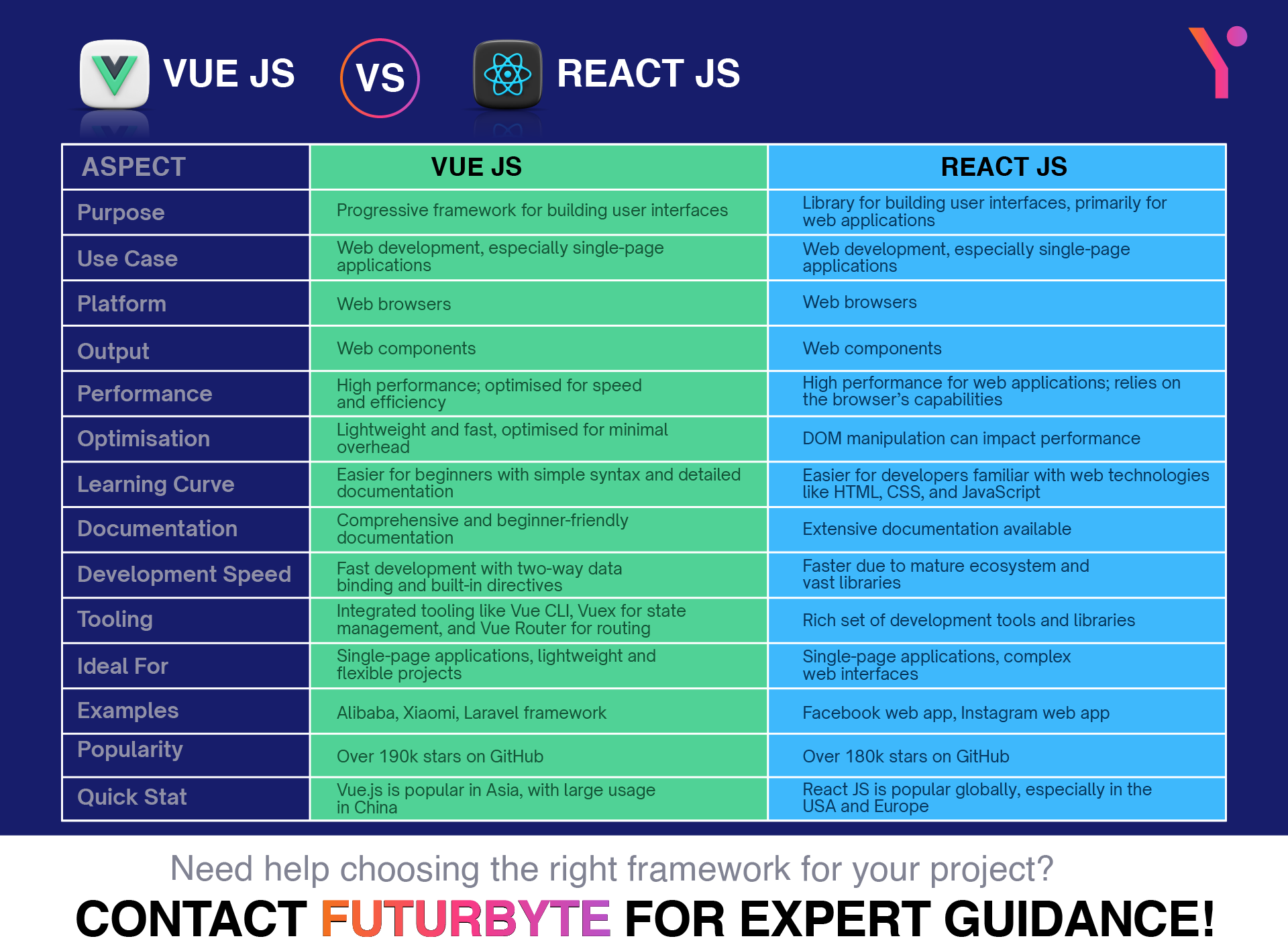Can’t decide between Vue.js vs React.js for your next project? This blog post throws down in a JavaScript showdown! Let’s compare features, performance, and use cases to help you pick the champion framework for building your web application.
The diversities in software development are endless since we have different use cases and devices. This requires your attention to the application development trends more than ever. With many languages, frameworks, and libraries, Vue.js and React.js are leading the way in this technological advancement; both of these have their distinctive use cases at this particular time.
Note that vue.js is a framework and React.js is a library. Vue.js provides an opinionated code architecture while React.js concentrates on user interfaces, providing developers with greater freedom in organising their applications.
React.js is backed by Meta and boasts a massive 40% user base among developers worldwide. In contrast, Vue.js is favored by many renowned companies globally, such as Alibaba and Xiaomi, and is chosen for smaller and mid-sized projects, with a loyal following of 20% of developers.
But why pit them against each other? Here’s the deal: Choosing what’s best requires a deeper understanding of your project scope. That’s why you must consult with experts and discuss your project to ensure its successful completion, regardless of the technology chosen.
Without further ado, let’s have a head-to-head comparison that will delve into their features, performance, and use cases. This blog will give you a clear picture of what each framework (Vue.js) and library (React.js) brings to the table.

Vue.js vs React.js – A Quick Comparision
| Feature | Vue.js | React.js |
| Type | Framework | Library |
| Learning Curve | Easier; gentler introduction to component-based architecture | Steeper; requires an understanding of JSX and concepts like Virtual DOM |
| Syntax | HTML templates (with optional JSX) | JSX (JavaScript extension for HTML-like syntax) |
| Data Binding | Two-way data binding (simpler for beginners) | Unidirectional data flow (requires more planning) |
| Rendering | Efficient; compiles updates into DOM changes | Utilises Virtual DOM for faster re-renders |
| Ecosystem | Growing; focuses on core functionality and ease of use | More mature; wider range of tools and libraries |
| Community | Active and friendly; known for good documentation | Very large and active; extensive resources available |
| Suitability | Ideal for projects that value simplicity and ease of learning | Well-suited for complex applications and those requiring cross-platform development (with React Native) |
Detailed Overview of Vue.js
Vue.js was developed by Evan You in 2014 as a modern JavaScript framework. The focus is on the presentation layer and is intended to be flexible. Vue.js makes it easy for developers to create user interfaces and single-page applications due to its straightforward and adaptable structure.
Key Features of Vue.js
- Reactive Data Binding: Vue.js ensures that your data is synchronised with your web page. When you modify the information, the webpage will automatically refresh.
- Component-Based Architecture: Vue.js lets you create reusable building blocks for your web app. You can organise your code to create larger application like business management software solutions.
- Virtual DOM: Just like React, Vue.js utilises a virtual DOM to enhance rendering and boost performance.
- Directives: Vue.js provides a set of directives like v-bind and v-model to enhance HTML with dynamic behaviour.
- Single-File Components: Vue.js lets you write your HTML, JavaScript, and styles all together in one file, simplifying project structure and maintenance.
Pros of Vue.js
- js is simple, but it demands your commitment and a thorough grasp of JavaScript.
- It is suitable for developing various applications, whether they are basic or complex.
- js provides thorough and organised documentation, aiding developers in problem-solving and comprehension of ideas.
- The Vue.js community is constantly expanding and thriving, offering a wide range of resources, plugins, and tools to support developers.
Cons of Vue.js
- js lacks the extensive corporate support that React has, which may impact its long-term sustainability and assistance.
- Even as Vue’s ecosystem expands, it remains smaller than React’s, resulting in fewer available libraries and third-party integrations.
- Since Vue.js was developed in China, many resources and community discussions are in Chinese, making it difficult for non-Chinese speakers to understand
Vue.js is recognised for its simplicity and flexibility. It is a great choice for developers looking for a user-friendly framework to create dynamic web applications. Still, it’s important to consider corporate support and the size of the Vue.js ecosystem when determining if it is the best choice for your project.
Detailed Overview of React.js
React.js is a library created by Meta in 2013. The purpose of React.js was to develop user interfaces using JavaScript. With React.js, you get reusable UI components that can effectively handle application state. React.js is commonly utilised for creating single-page applications and mobile applications, due to its virtual DOM and component-based structure.
Key Features of React.js
- Virtual DOM: React.js uses a virtual DOM to optimise rendering performance, updating only the components that have changed.
- Component-Based Architecture: React.js structures applications into reusable components, promoting code reuse and easier maintenance.
- JSX: React.js uses JSX, an extension that enables developers to include HTML-like code in JavaScript, enhancing code clarity and speeding up development processes.
- Unidirectional Data Flow: React.js guarantees a one-way flow of data, simplifying the process of debugging and comprehending the effects of data modifications on the application.
- Strong Community Support: React.js has a large and active community, providing numerous resources, libraries, and tools to support development.
Pros of React.js
- js is efficient, especially for large applications, due to its virtual DOM and effective diffing algorithm.
- js encourages the development of reusable components, leading to time savings and enhanced code quality.
- js offers libraries, tools, and community resources that simplify the process of finding solutions and incorporating different technologies.
Cons of React.js
- js can be tougher than Vue.js for newcomers because it is more complex and dependent on JSX.
- js demands more boilerplate code, leading to potentially longer setup time and increased complexity.
- Developers need to keep up with React.js updates to avoid compatibility problems caused by the frequent changes.
To summarise, React.js stands out in performance, reusability, and community backing, proving to be a better option for big projects. Nevertheless, the steep learning curve and regular updates could be difficult for developers. So, the decision of whether to go with Vue.js or React.js hinges on the requirements and environment of your project.
Performance Comparison: Vue.js vs React.js
Both Vue.js and React.js are recognised for their outstanding performance, although there are slight distinctions that should be taken into account. Let’s analyse their performance by focusing on the main aspects: speed and efficiency, as well as rendering methods.
Speed & Efficiency
In terms of speed, React has a slight edge as it utilises a Virtual DOM, which makes a lightweight representation of the actual DOM. Vue.js is also very capable. Its leaner core library and focus on simplicity contribute to its own efficiency.
For small to medium-sized applications, the performance gap between Vue.js and React.js is minimal. In complex applications like fintech software development, React’s Virtual DOM could provide a small benefit.
Rendering Mechanisms
Vue.js and React.js have distinct methods for rendering. Vue.js employs a bidirectional data binding mechanism, which ensures that any modifications in the data will automatically reflect in the DOM, and vice versa. This can be intuitive for developers, especially those with a traditional web development background.
React.js, in contrast, uses a one-way data flow system. Updates in the data cause the components relying on that data to be re-rendered. This method may require additional planning but provides detailed control over updates.
Common Use Cases for Vue.js
Vue.js is a versatile framework that is well-suited for a variety of web development projects. Here are some of its most common use cases:
Single-Page Applications (SPAs)
Vue.js is particularly good at creating SPAs that offer a seamless and quick user experience through dynamic content loading, avoiding the need for complete page refreshes. This is perfect for web applications that need a similar experience to a desktop. Common instances consist of social media platforms and online shopping websites.
https://laravel.com/frontend is a popular PHP framework that offers Vue.js integration for building modern SPAs. Many companies, including Alibaba and Netflix, leverage Laravel and Vue.js to create their web applications.
Interactive Web Applications
Vue’s reactivity system makes it perfect for creating dynamic and interactive web experiences. This ranges from building data visualisations and dashboards to crafting rich user interfaces for content management systems.
https://www.grammarly.com/ is a popular grammar-checking and writing enhancement tool. Vue.js powers the interactive elements within the Grammarly editor, allowing users to seamlessly interact with suggestions and corrections.
Prototyping & Minimum Viable Products (MVPs)
The simple syntax of Vue.js makes it a great choice for quickly building prototypes and MVPs. This allows developers to validate ideas and gather user feedback early in the development process.
Real-World Example: Wedo is a platform for design collaboration that enables teams to work on design projects simultaneously. The company employed Vue.js to quickly create a prototype of their first MVP and collect user input before committing to a comprehensive development procedure.
Progressive Web Applications (PWAs)
Vue’s lightweight nature makes it well-suited for building PWAs. These applications combine the best of web and mobile, offering offline functionality and a native-like experience.
https://vuejs.org/ CLI (Command Line Interface) includes tools specifically for building PWAs with Vue.js. The Starbucks app is a well-known example of a PWA built with Vue.js, offering users a fast and convenient way to order and pay for their coffee.
Common Use Cases for React.js
React’s popularity stems from its ability to handle complex web applications effectively. Here are some of its prominent use cases:
Large-Scale Enterprise Applications
React’s scalability and modularity make it a strong contender for building complex enterprise applications that require handling a lot of data and functionality.
https://www.facebook.com/ utilises React extensively to build and maintain its social networking platform. React’s component-based architecture allows Facebook to manage its complex UI efficiently and make updates seamlessly across its massive user base.
Social Networking Platforms
The need for dynamic updates and user interactions makes React a popular choice for building social media platforms like Facebook or Twitter.
https://www.netflix.com/ uses React to power the interactive elements of its streaming platform. This allows users to browse content, manage their queues, and control playback seamlessly within the web application.
Data-Heavy Web Applications
React’s Virtual DOM efficiently manages complex UIs that update frequently based on data changes. This makes it ideal for data visualisation tools and real-time dashboards.
https://www.tableau.com/ is a popular data visualisation platform used by businesses to create interactive dashboards and reports. React allows Tableau to render complex charts and graphs efficiently, even when dealing with large datasets.
Reusable UI Components
React’s component-based architecture encourages React JS development company to build reusable and maintainable UI components, which is crucial for large-scale applications with consistent design patterns.
Real-World Example: (Airbnb, Netflix, Uber) While both Vue.js and React.js excel in their respective areas, the best choice ultimately depends on the specific needs of your project and your team’s skillset.
What’s Best for Your Project: FuturByte’s Take
Can’t decide what’s right between Vue.js and React.js for your next web project? Don’t worry; our developers are ready to assist you! We offer expert consultations to help you make an informed decision.
Our software developers dive into the intricacies of your project’s needs. We consider everything from how complex your app is to your business requirements and your long-term goals. With this intel, we’ll recommend the framework and library that’s the perfect fit for you.
Maybe you value a simpler, more flexible approach – that’s where Vue.js shines. Or perhaps you need top-notch performance and the ability to handle a ton of data – React.js might be your champion. Whatever your needs, FuturByte will ensure you make the best choice for a smooth development process and a successful project.
But our expertise goes beyond consultations! FuturByte offers full-service web development, taking your project from concept to launch. Our experienced team of developers is well-versed in both Vue.js and React.js, so rest assured, your application will be built using the latest tech and best practices.
With FuturByte by your side, you can confidently turn your idea into a potent and scalable web application. Let’s chat and turn your project into a reality!
Final Thought
Deciding between Vue.js and React.js depends on what your project requires. Vue.js is well-suited for beginners and small projects due to its simplicity and seamless integration capabilities. Alibaba and GitLab have demonstrated that it is excellent for quick prototyping and improving current projects.
React.js excels in large-scale applications and mobile development with React Native. It handles high-traffic, data-intensive environments efficiently, as demonstrated by Facebook, Instagram, and Airbnb. React’s vast ecosystem offers extensive resources for development and optimisation.
Ultimately, your choice depends on project complexity, team expertise, and specific requirements. Both Vue.js vs React.js deliver high-quality applications, but understanding their strengths will help you make an informed decision.
Frequently Asked Questions
Consider your project’s complexity, development team’s expertise, scalability needs, and long-term support requirements. Vue.js is great for simplicity and ease of learning, while React.js excels in performance and handling complex applications.
React.js typically has a steeper learning curve due to its JSX syntax and unidirectional data flow. Vue.js, with its HTML-based templates and gradual adoption approach, is often considered easier for beginners.
FuturByte provides expert consultations where we analyse your project’s requirements, scalability needs, and long-term goals. Based on this assessment, we recommend the framework that best aligns with your project’s objectives and technical feasibility.
FuturByte offers end-to-end web development services from initial concept to final deployment. This includes architecture design, frontend and backend development using Vue.js or React.js, integration of third-party services, testing, and ongoing maintenance to ensure your application’s performance and security.
Have questions or feedback?
Get in touch with us and we‘l get back to you and help as soon as we can!




